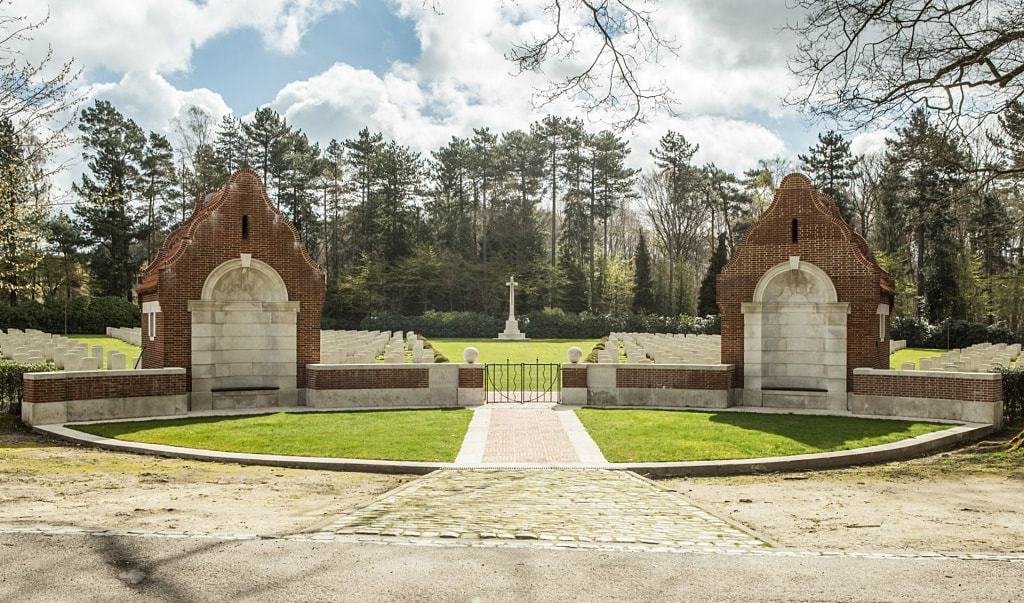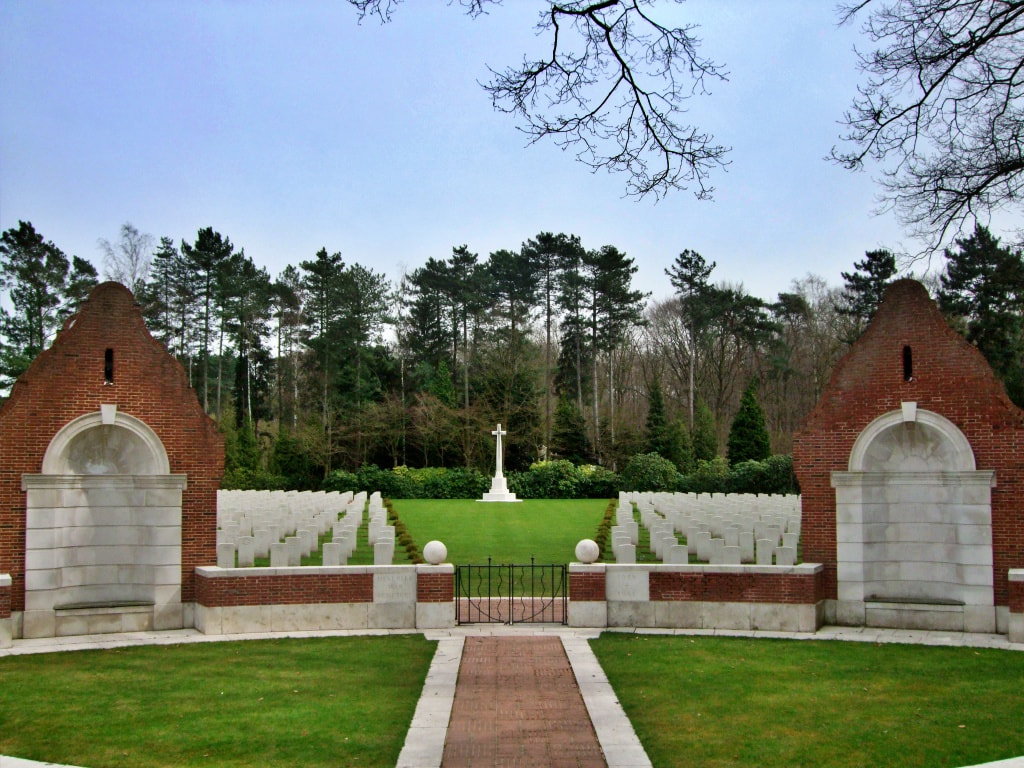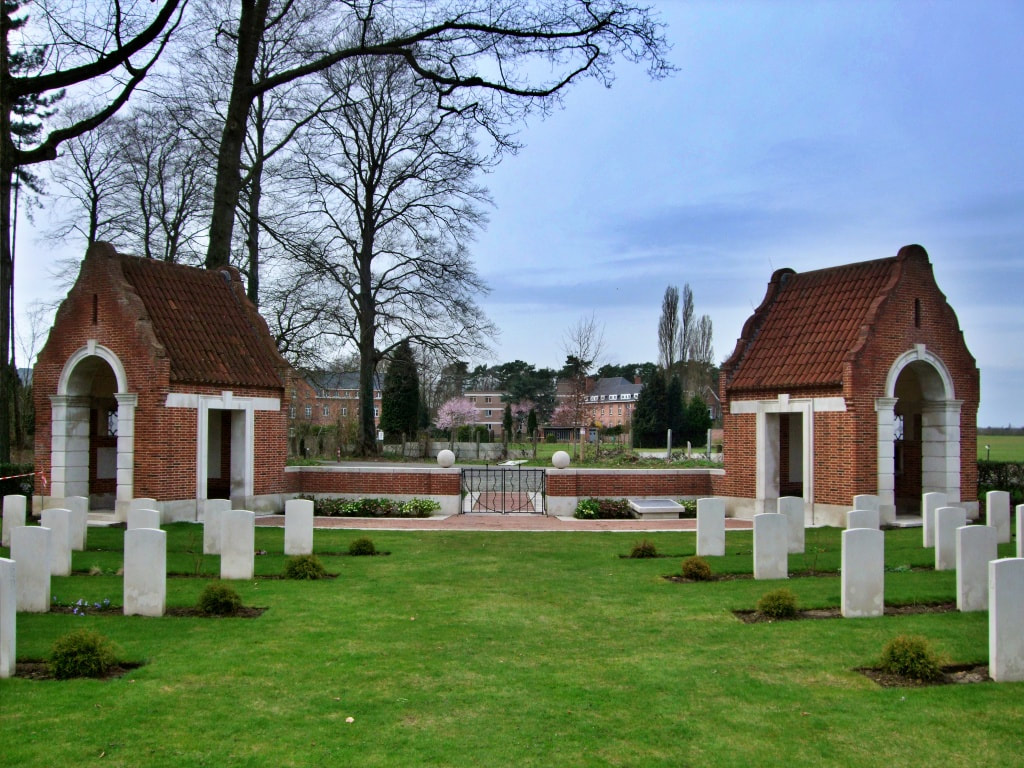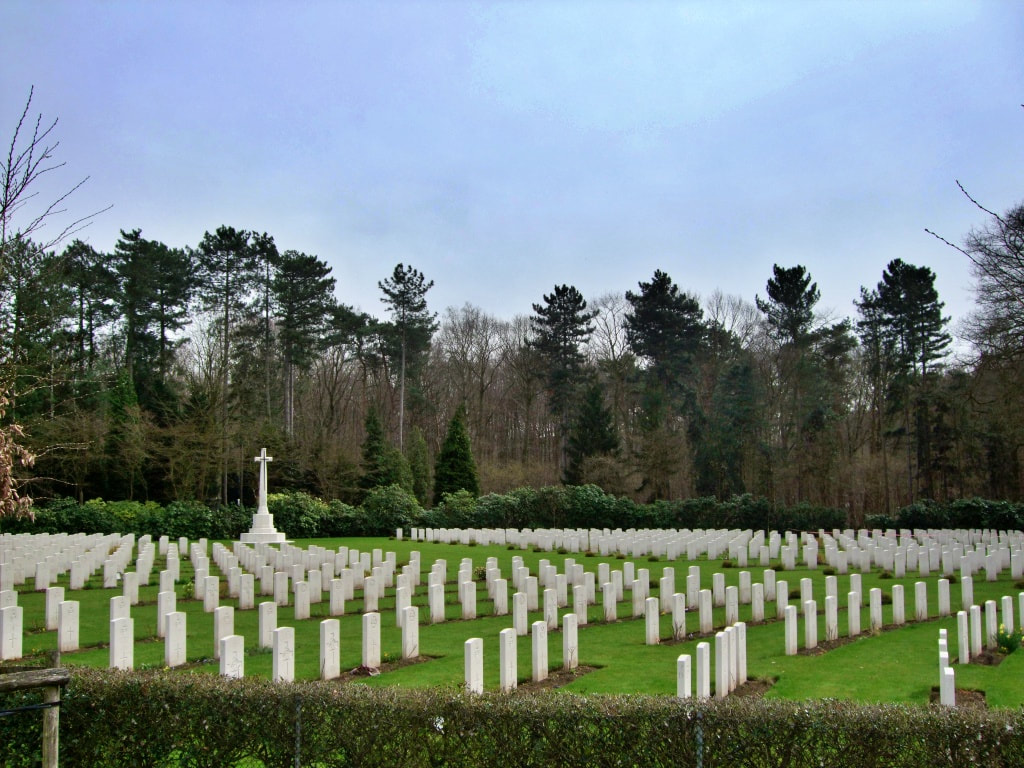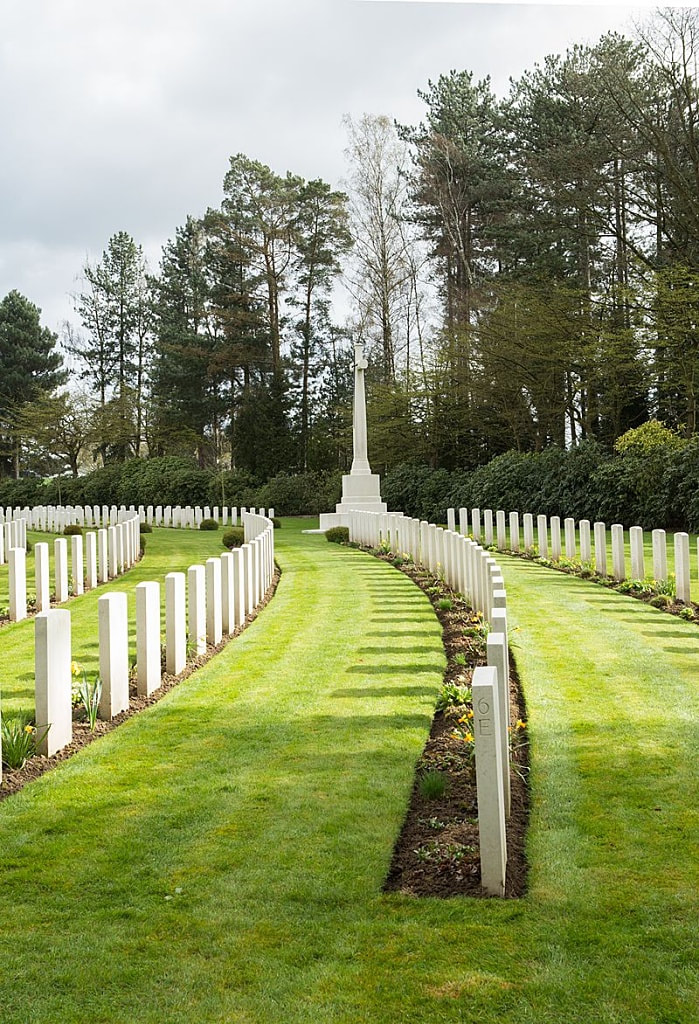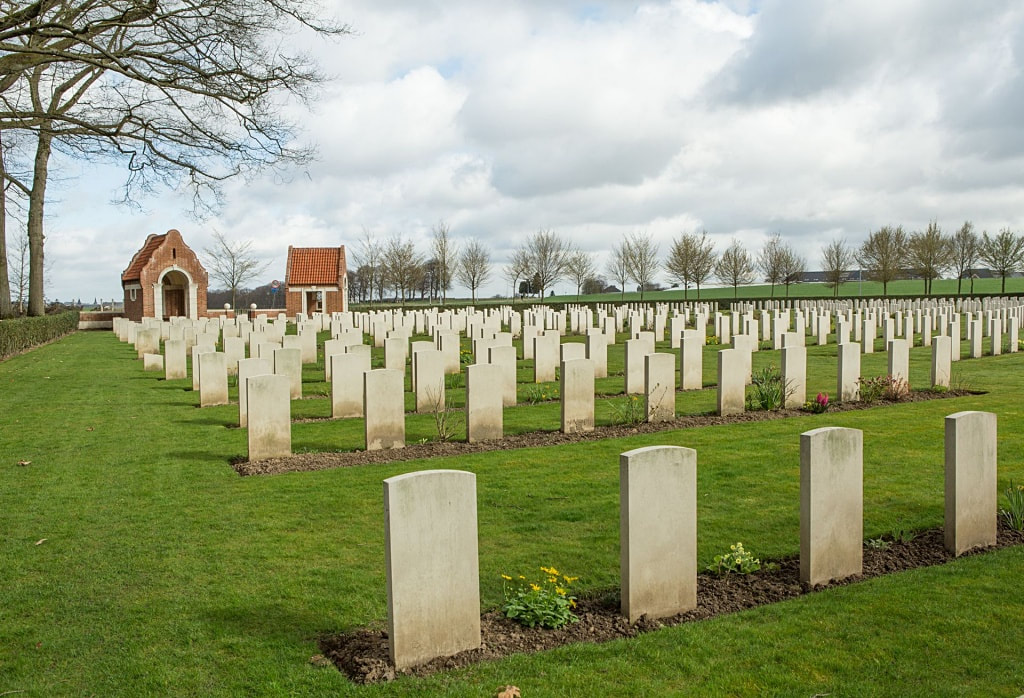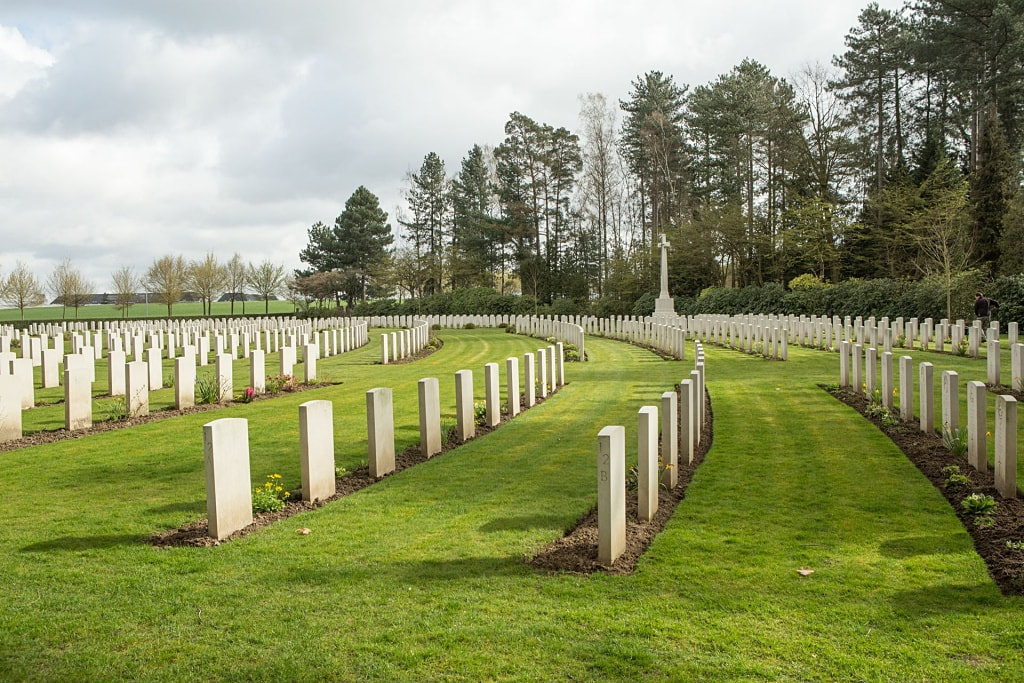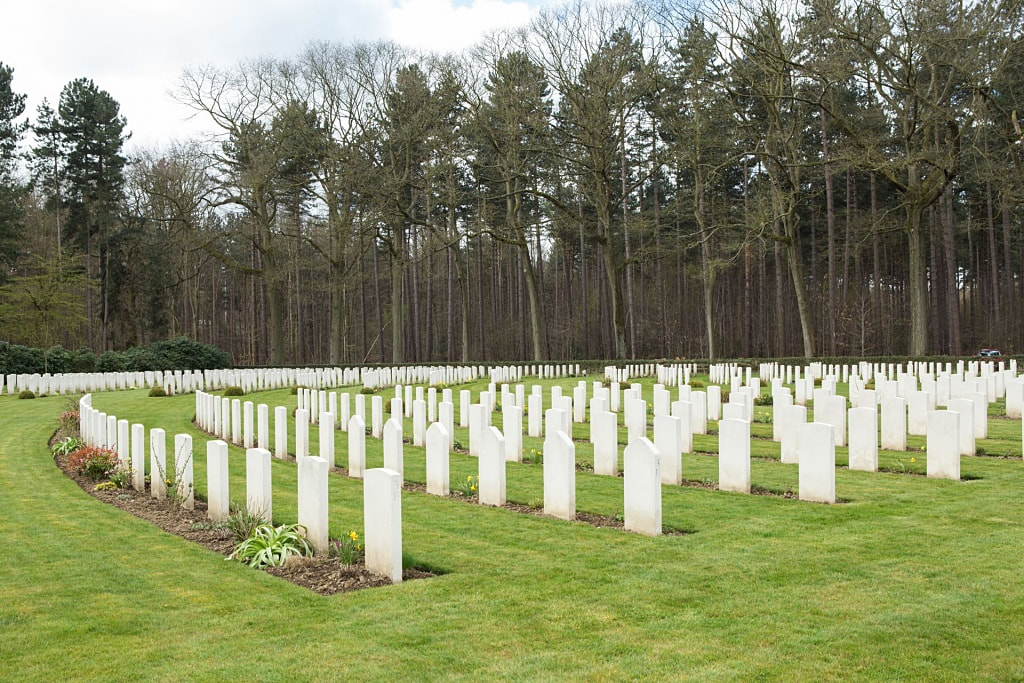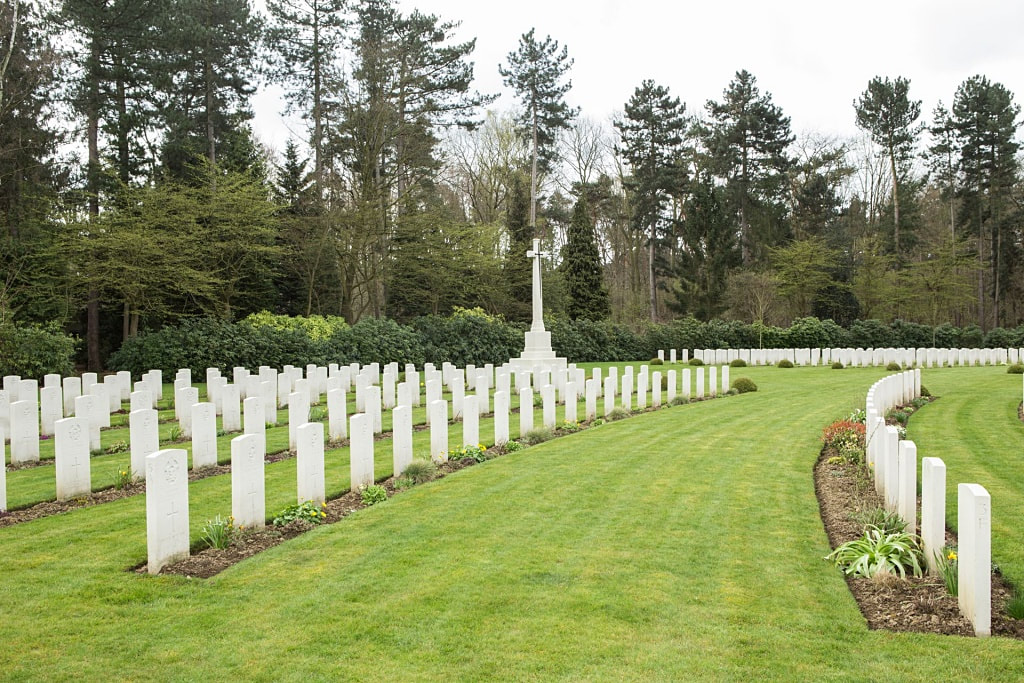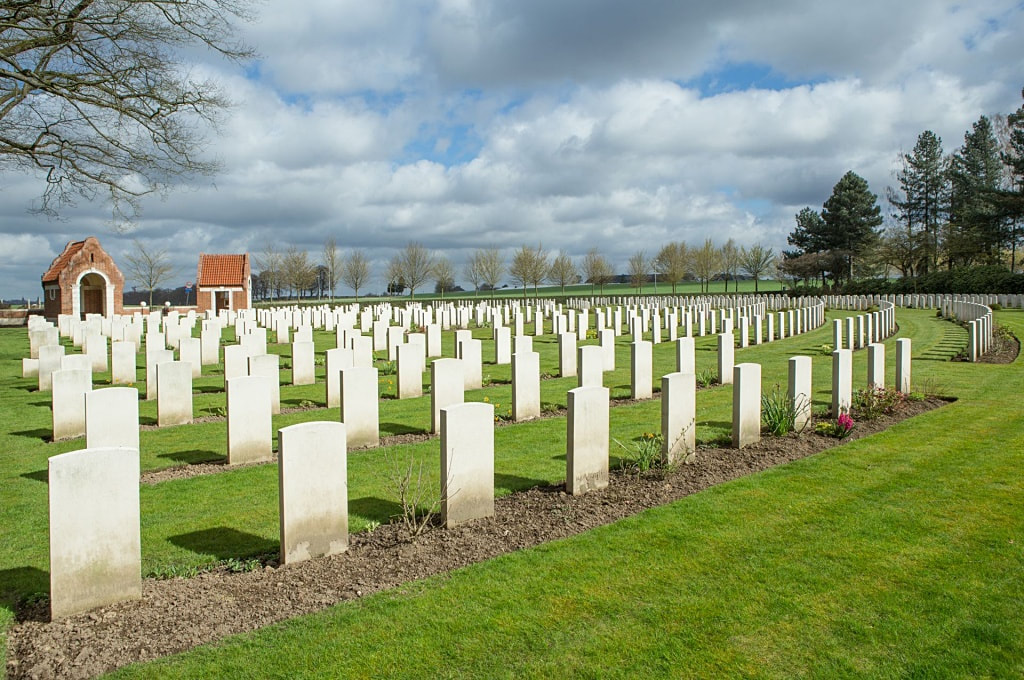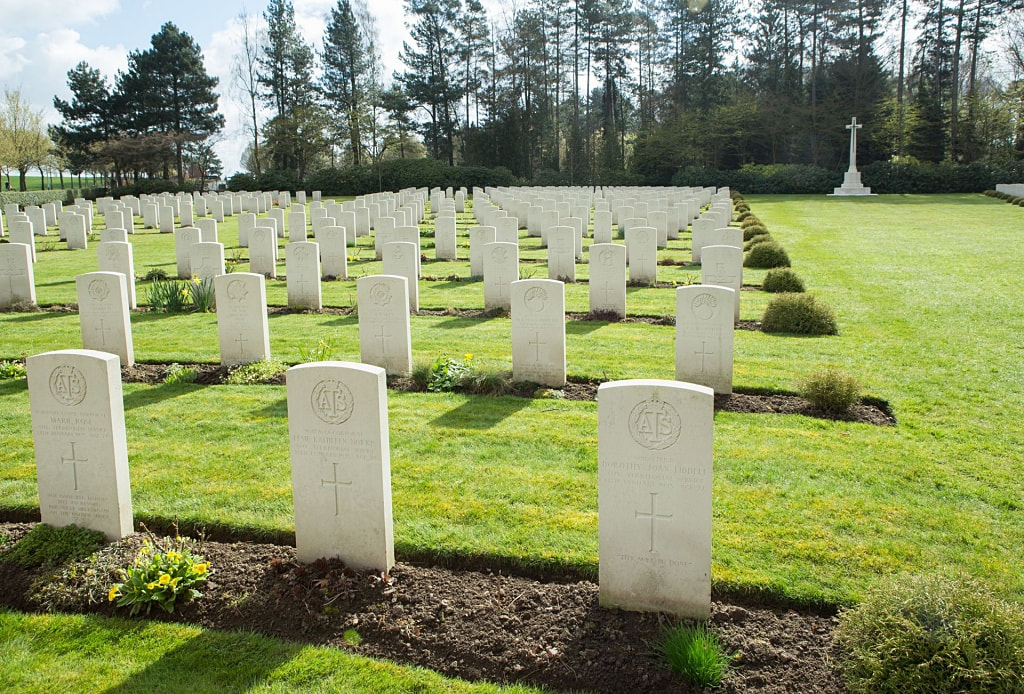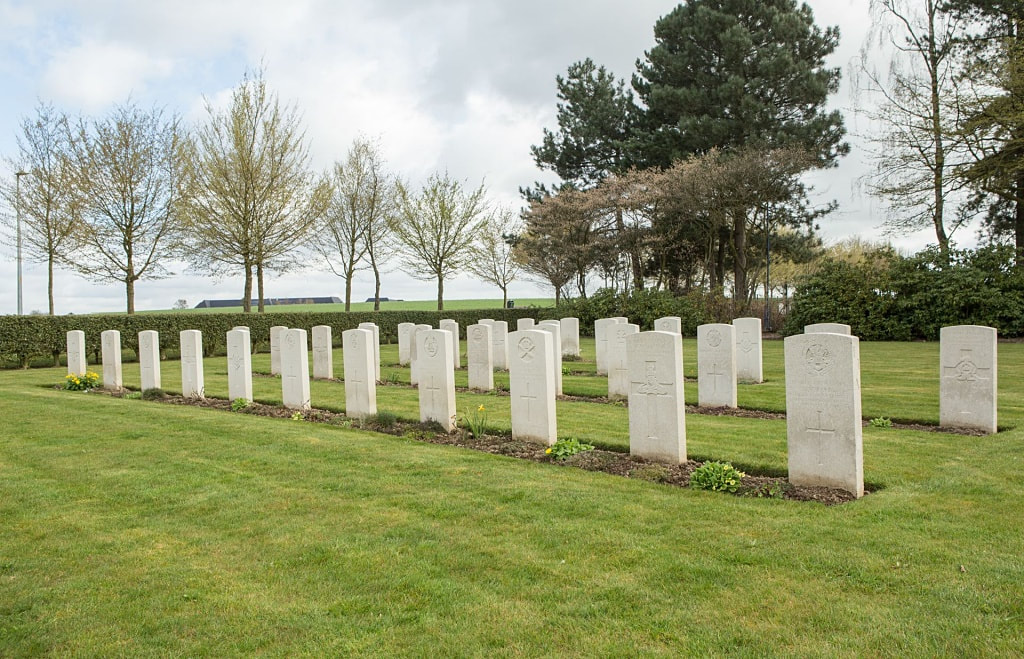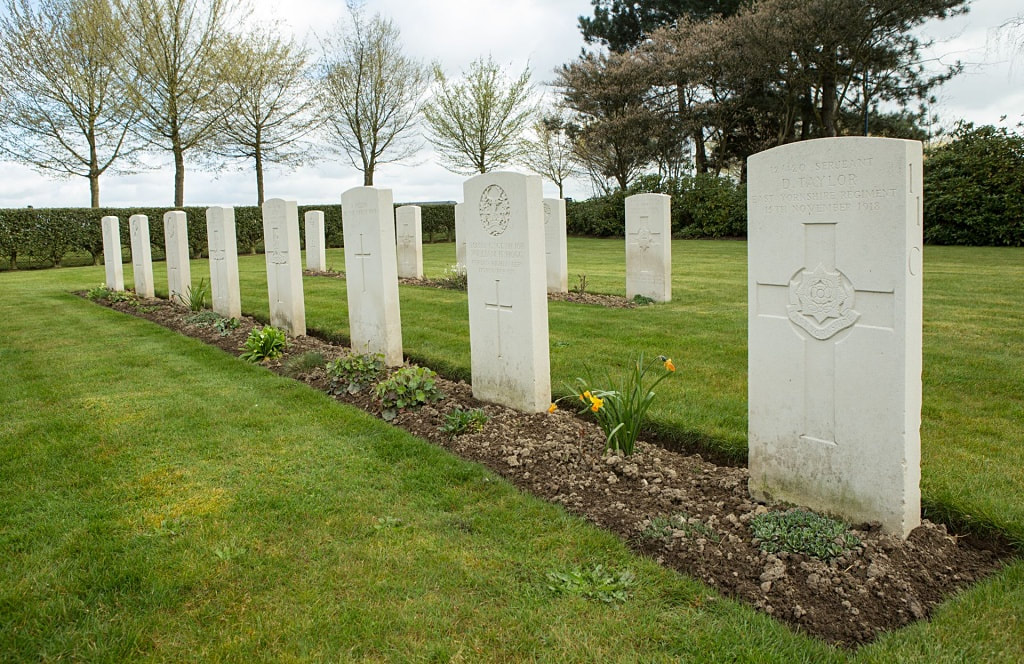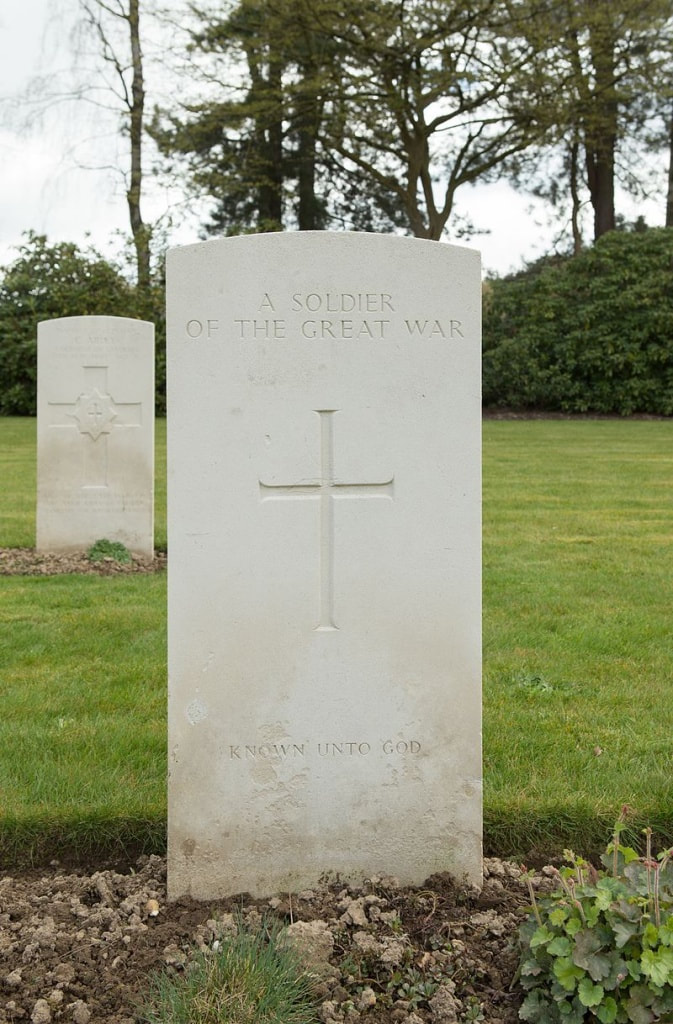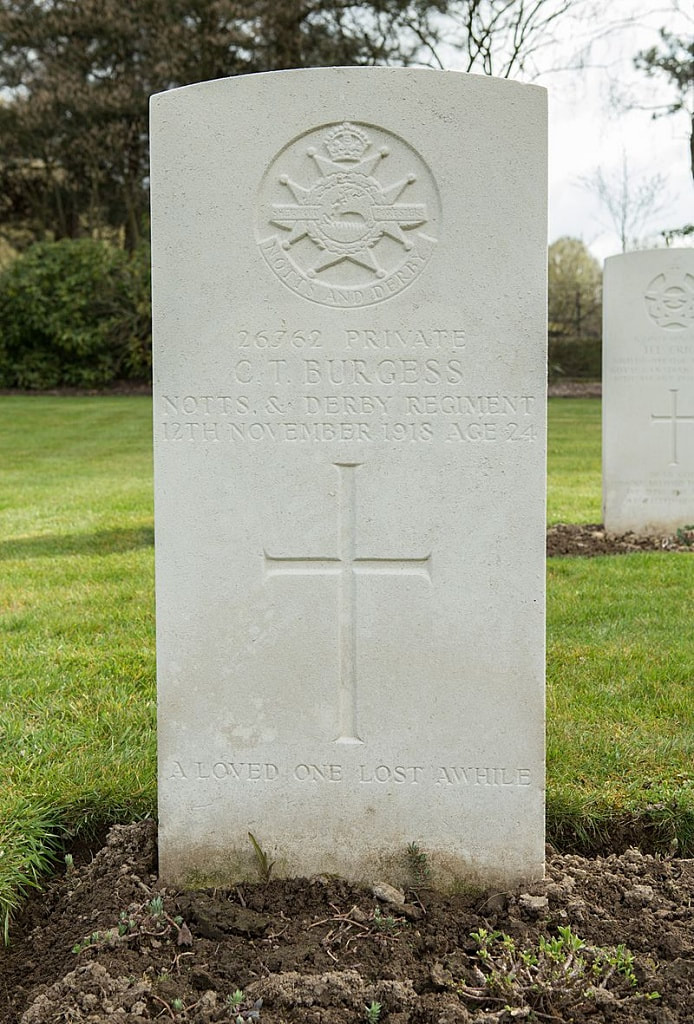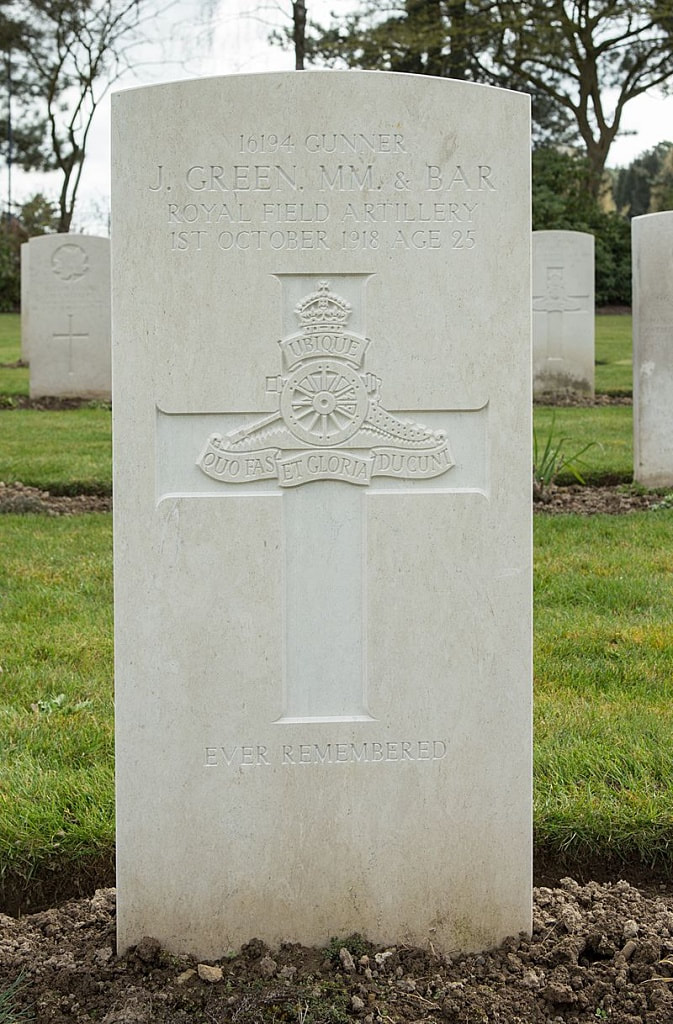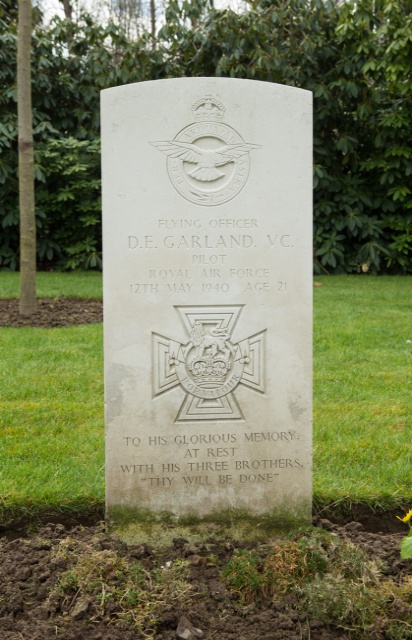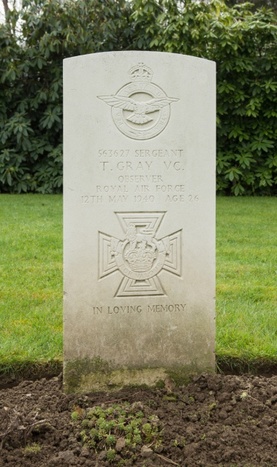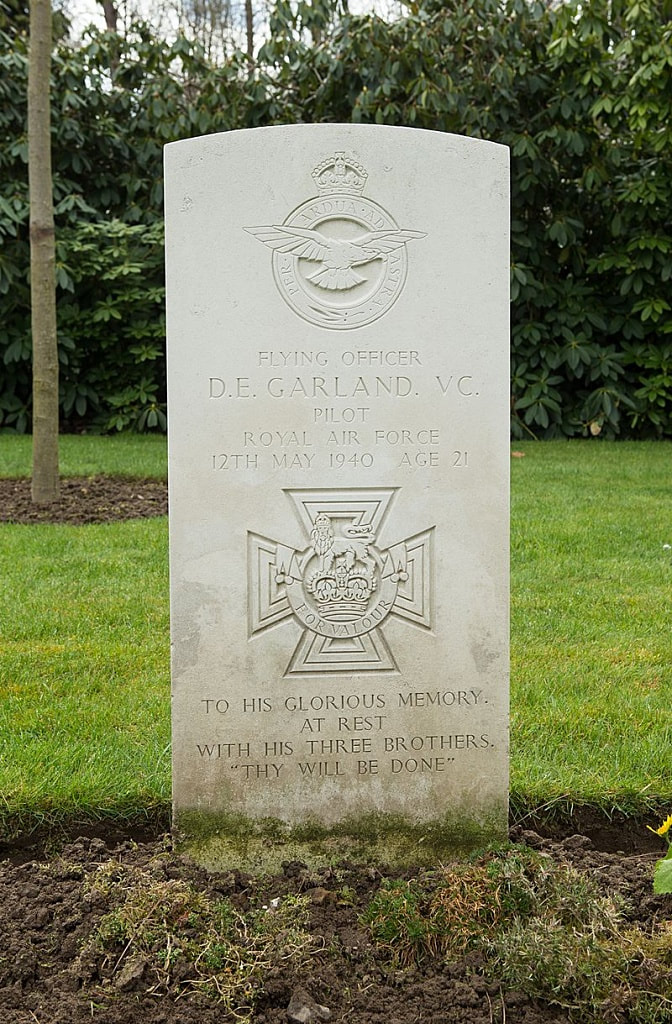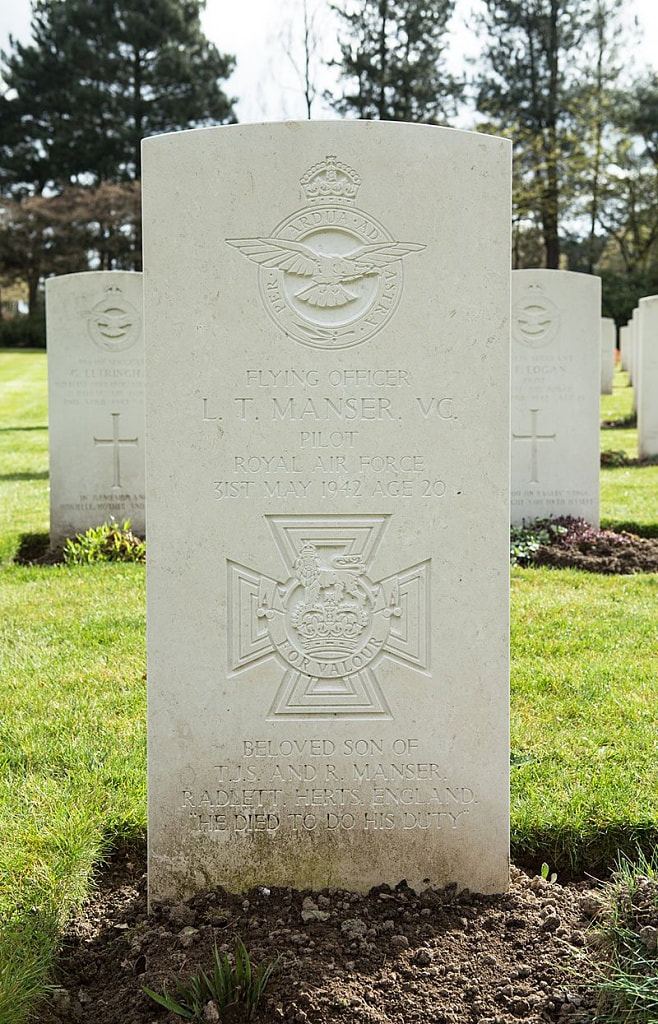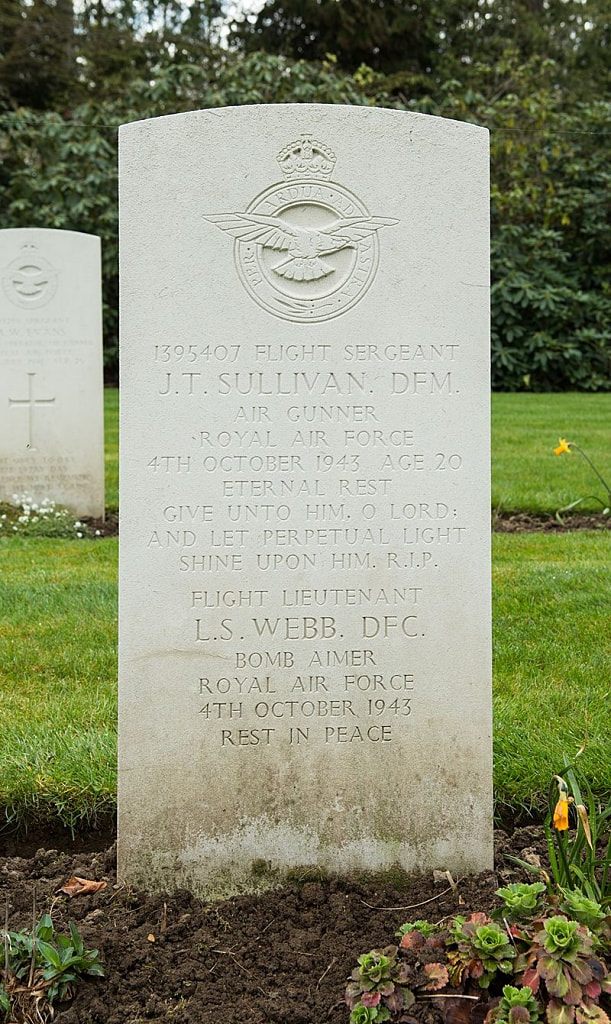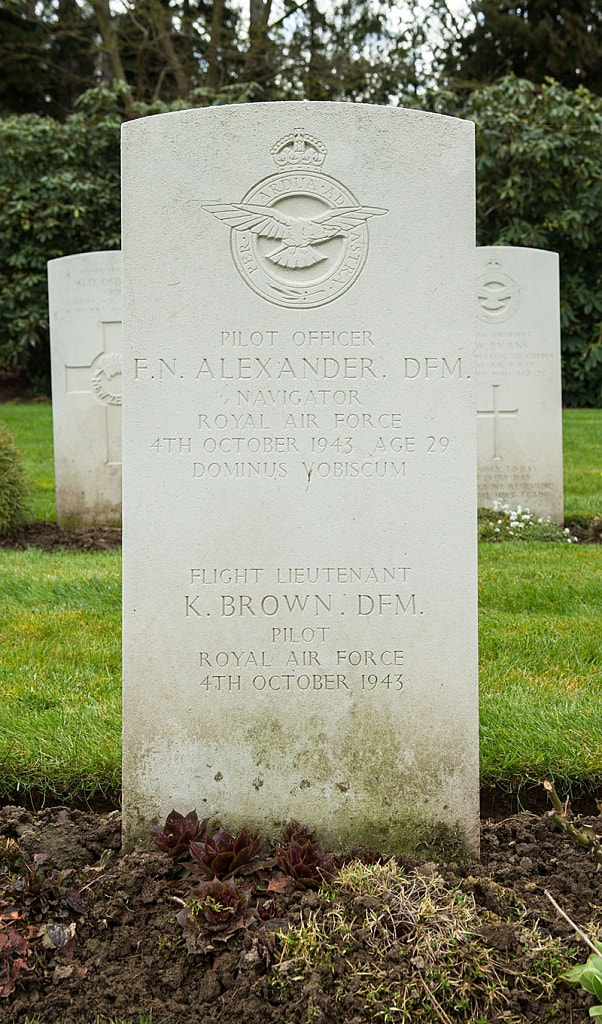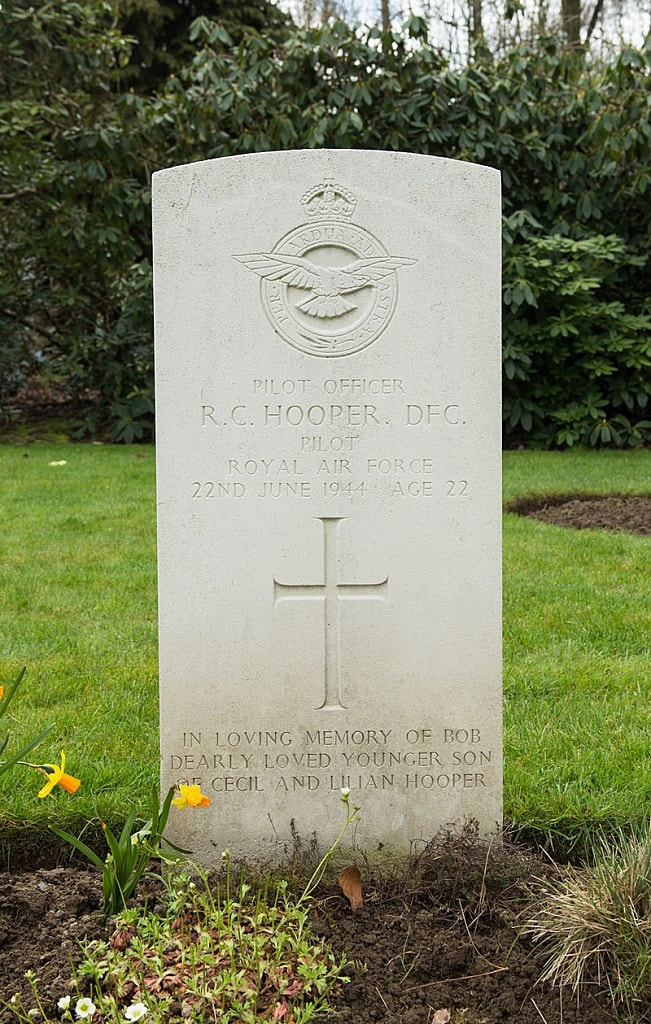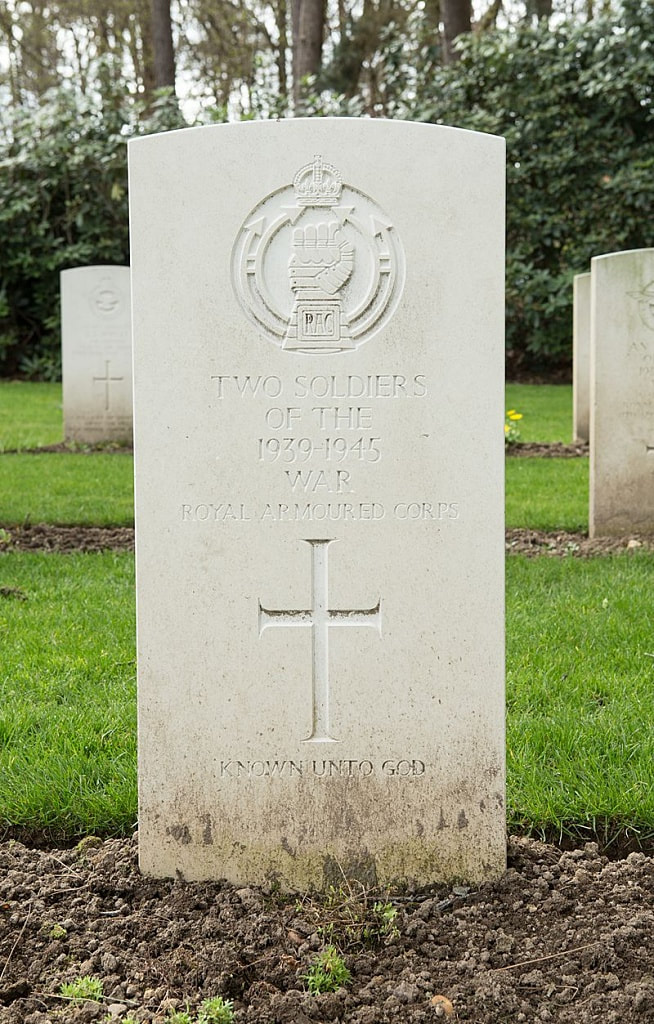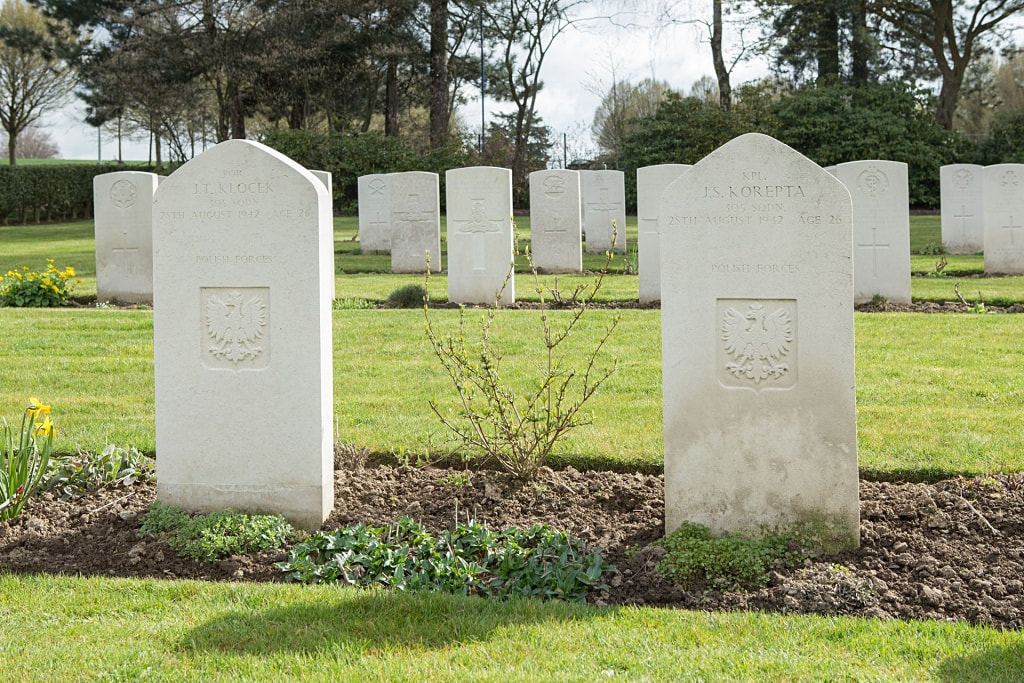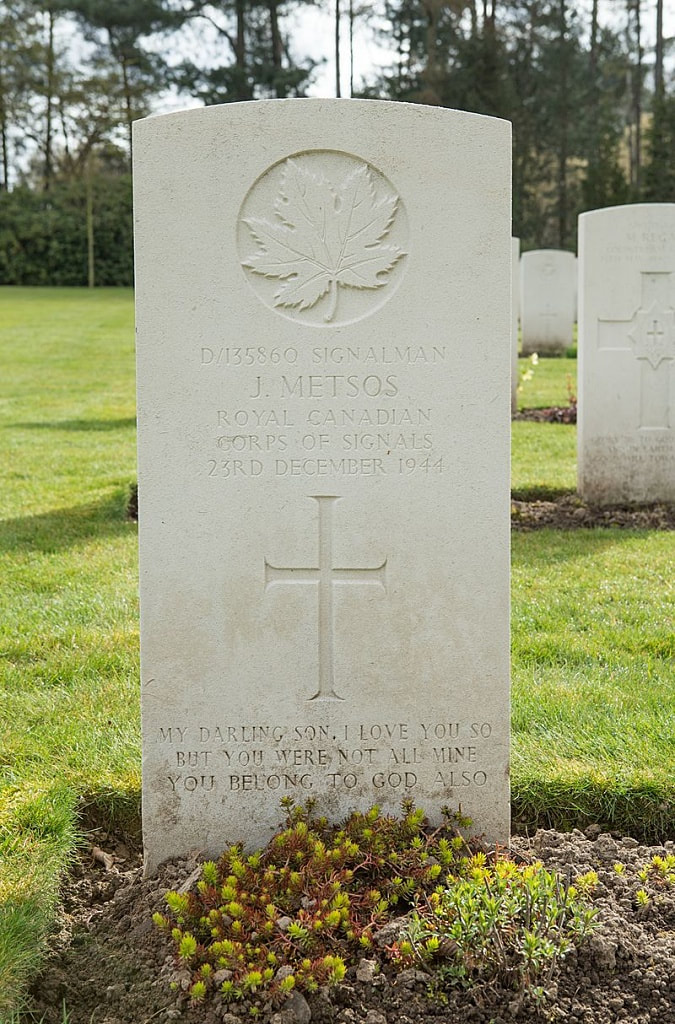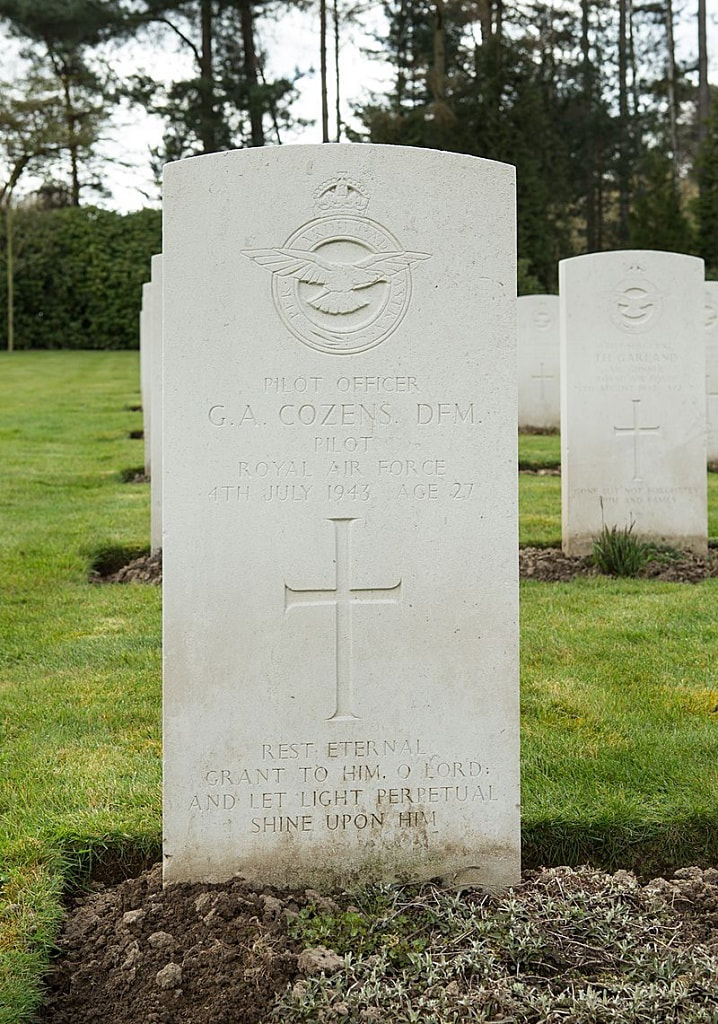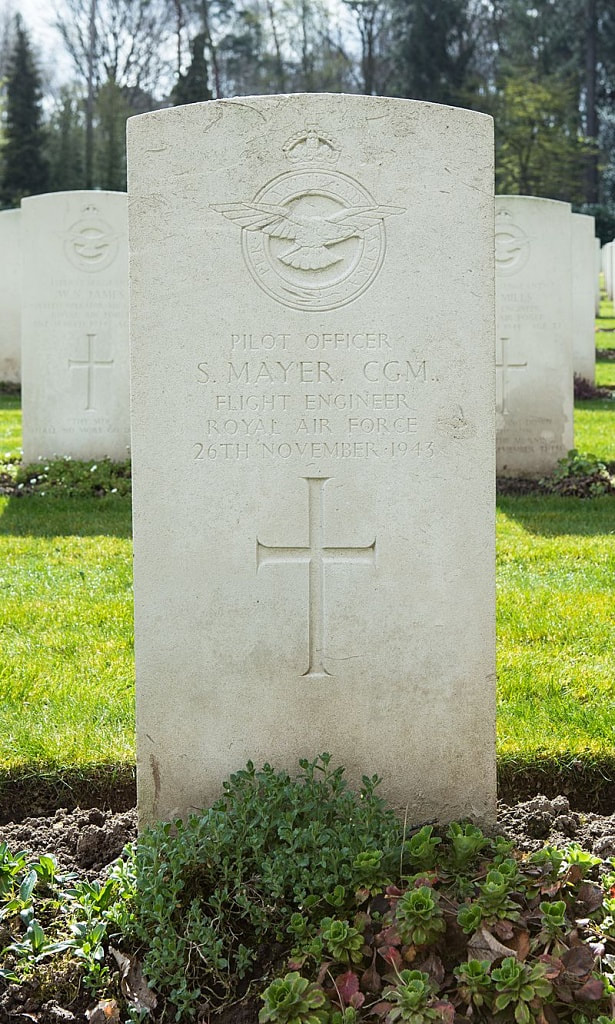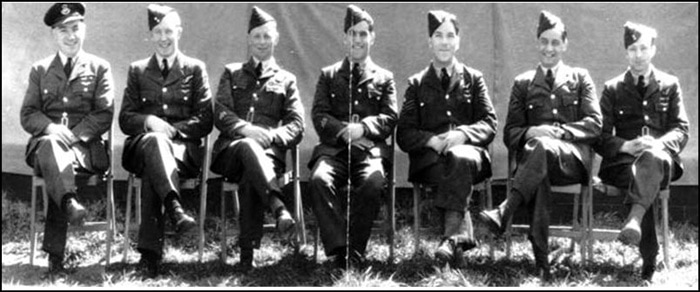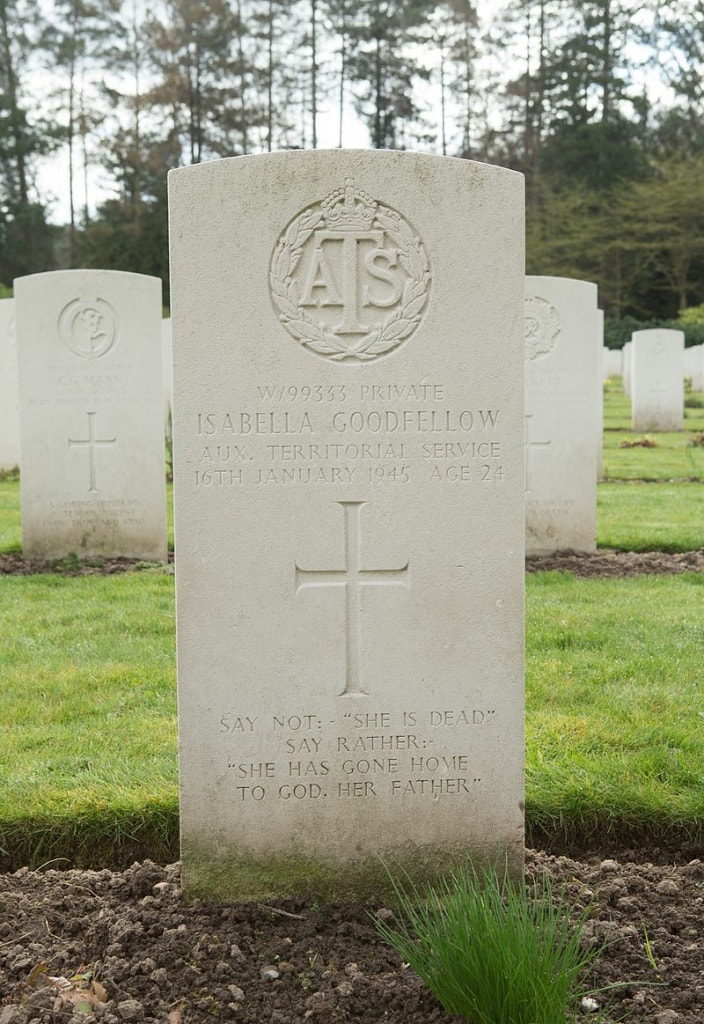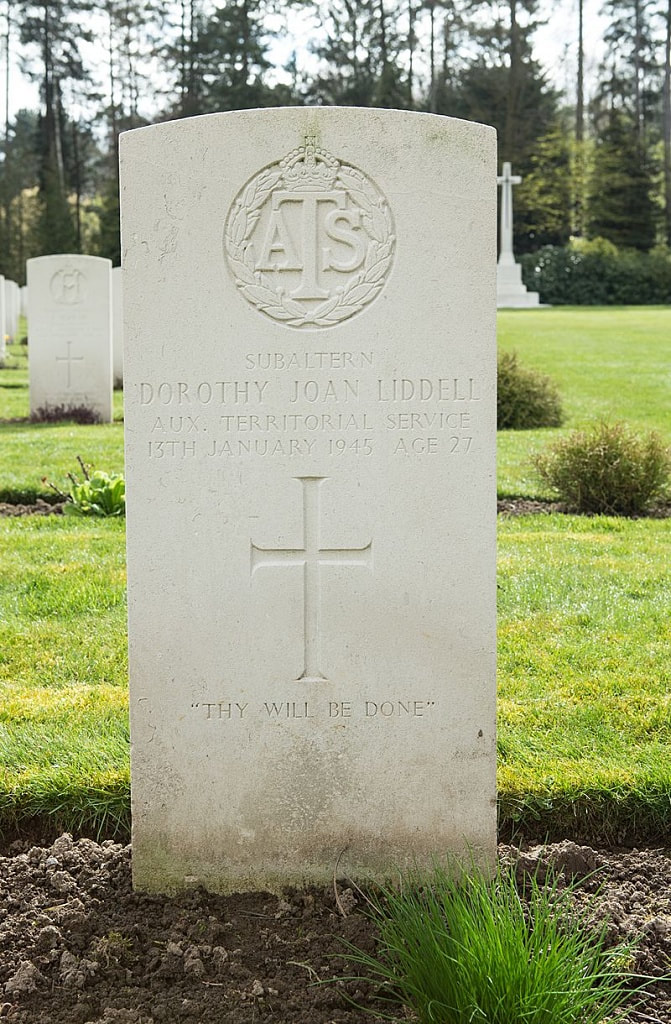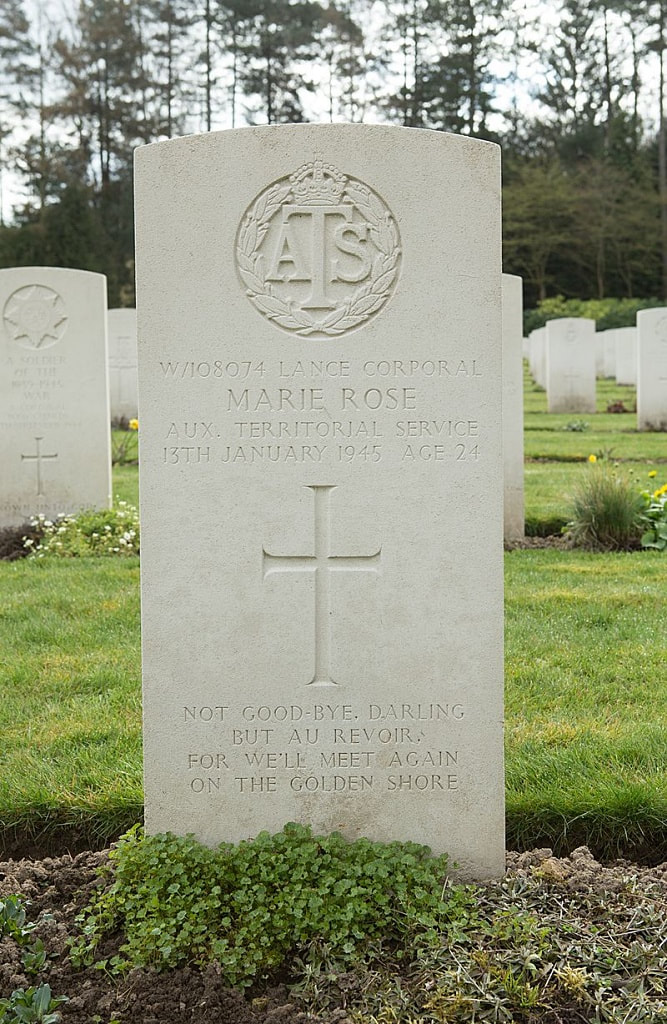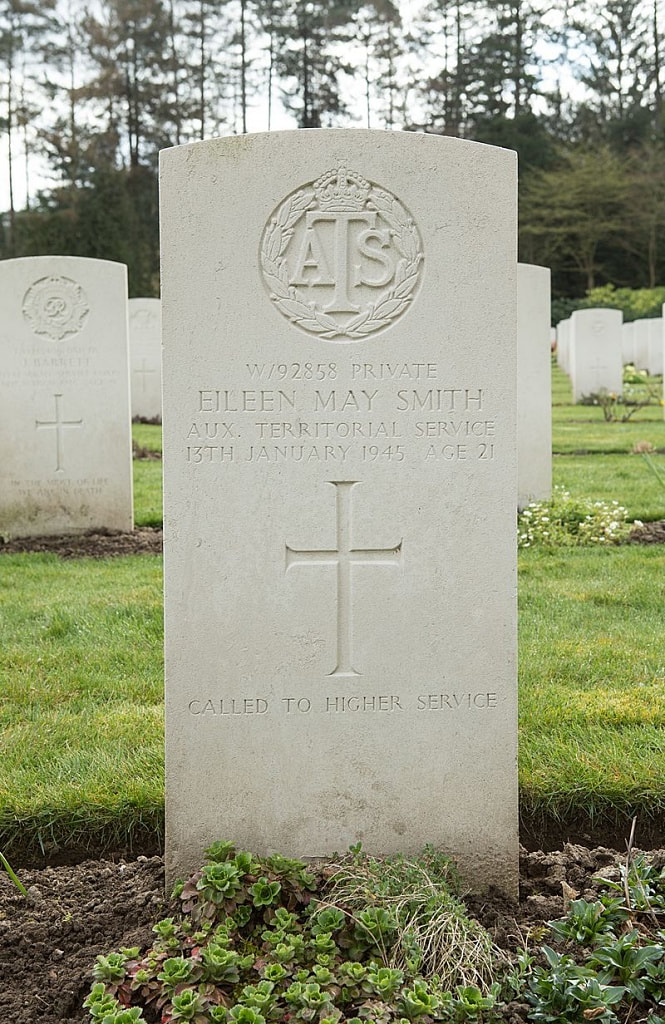HEVERLEE WAR CEMETERY
Vlaams-Brabant
Belgium
GPS Coordinates Latitude: 50.8481 Longitude: 4.70278
Location Information
Heverlee War Cemetery is located 30 kilometres from Brussels and 3 kilometres south of Leuven. Turn left out of Leuven railway station onto the Tiensevest (ring road R 23). Follow the Tiensevest through the junctions Tiensepoort and Parkpoort and along the Naamsepoort. Turn left at the Naamsepoort onto the Naamsesteenweg (N251), signposted Namen, Waver and Heverlee. Continue until you cross the railway line at Heverlee and take the first left turn into the Hertogstraat. Follow Hertogstraat to the end and turn right at the Sport Hall onto the Kerspelstraat. Continue down the Kerspelstraat until you come to a crossroads at which the cemetery is located.
Visiting Information
Wheelchair access to this cemetery is possible via the main entrance.
Historical Information
The British Expeditionary Force was involved in the later stages of the defence of Belgium following the German invasion in May 1940, and suffered many casualties in covering the withdrawal to Dunkirk. Commonwealth forces did not return until September 1944, but in the intervening years, many airmen were shot down or crashed in raids on strategic objectives in Belgium, or while returning from missions over Germany.
The original burial ground at Heverlee was on the opposite side of the lane. It was used after the liberation for burials from the 101st British General Hospital, which was then housed in Heverlee Girl's School close by. In July 1946, the present cemetery was started and was used for burials brought in from a wide area round about.
The cemetery now contains 977 Commonwealth burials of the Second World War, 37 of them unidentified. There are also 29 First World War burials which were brought into the cemetery from Wetteren Communal Cemetery, Gouvy Churchyard, Linerle, Uccle Communal Cemetery, Boneffe Churchyard, Luttre Communal Cemetery, Anderlecht Communal Cemetery, Sclayn Communal Cemetery, Tubize Communal Cemetery and Gerozstein German Military Cemetery, where their security and maintenance could not be guaranteed.
In addition to the Commonwealth burials, the cemetery also contains the graves of one American and 11 Polish airmen.
The cemetery was designed by P.D. Hepworth.
Total Burials: 1,021.
World War One Identified Casualties: United Kingdom 28, Canada 1. Total 29.
World War One Unidentified Casualty: 1. Total 1.
World War Two Identified Casualties: United Kingdom 722, Canada 157, Australia 45, New Zealand 17, Poland 11, U. S. A. 1, South Africa 1. Total 954.
World War Two Unidentified Casualties: 37.
Images in this gallery © Werner Van Caneghem
Some of the World War One Graves and Cemetery Plan
Pictures © Werner Van Caneghem
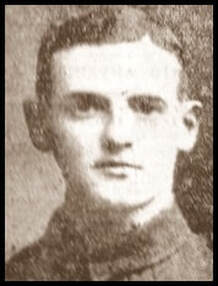
16194 Signaller
John Green M.M. & Bar
16194 Royal Field Artillery 251st Bde.
Died of Wounds 8th October 1918, aged 25
Plot XI. A. 4.
Picture of Headstone in "Some of the World War One Graves" gallery above
Son of William Henry and Mary Ann Green; husband of Sarah Jane Green, of 46, Dall St., Burnley.
John Green M.M. & Bar
16194 Royal Field Artillery 251st Bde.
Died of Wounds 8th October 1918, aged 25
Plot XI. A. 4.
Picture of Headstone in "Some of the World War One Graves" gallery above
Son of William Henry and Mary Ann Green; husband of Sarah Jane Green, of 46, Dall St., Burnley.
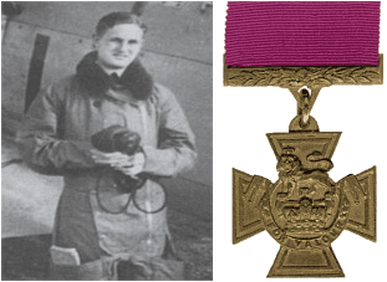
40105 Flying Officer
Donald Edward Garland, V. C.
12 Squadron, Royal Air Force
12th May 1940, aged 21.
Coll. grave 6. F. 14-16
Son of Patrick Joseph Garland, C.M.G., and of Winifred Irene Garland, of East Finchley, Middlesex. His brothers, Flt. Lieut. Patrick James Garland, Flt. Lieut. John Cuthbert Garland and Pilot Offr. Desmond
William Garland, also died on service. Patrick James is buried in Bergen-Op-Zoom War Cemetery in the Netherlands, John Cuthbert is buried in Midhurst Cemetery, Sussex in the U. K. and Desmond William is commemorated on the Runnymede Memorial.
His headstone bears the inscription "To His Glorious Memory. At Rest With His Three Brothers. "Thy Will Be Done"
Citation:
The citation in "The London Gazette," for 11th June, 1940, gives the following details : Flying Officer Garland was the pilot and Sergeant Gray the observer of the leading machine of a formation of five aircraft that were ordered to destroy at all costs a bridge over the Albert Canal which had not been demolished by the land forces and was allowing the Germans to advance into Belgium. In spite of very heavy defence of the area surrounding the bridge, the formation made a successful dive-bombing attack from the lowest practicable altitude, after releasing their bombs they were attacked by a large number of enemy fighters. Only one aircraft of the five returned to its base. Much of the success of the operation must be attributed to the formation leader, Flying Officer Garland, and to the coolness and resource of Sergeant Gray, who navigated the leading aircraft under most difficult conditions in such a manner that the whole formation, although it subsequently suffered heavy losses, was able successfully to attack the target.
Donald Edward Garland, V. C.
12 Squadron, Royal Air Force
12th May 1940, aged 21.
Coll. grave 6. F. 14-16
Son of Patrick Joseph Garland, C.M.G., and of Winifred Irene Garland, of East Finchley, Middlesex. His brothers, Flt. Lieut. Patrick James Garland, Flt. Lieut. John Cuthbert Garland and Pilot Offr. Desmond
William Garland, also died on service. Patrick James is buried in Bergen-Op-Zoom War Cemetery in the Netherlands, John Cuthbert is buried in Midhurst Cemetery, Sussex in the U. K. and Desmond William is commemorated on the Runnymede Memorial.
His headstone bears the inscription "To His Glorious Memory. At Rest With His Three Brothers. "Thy Will Be Done"
Citation:
The citation in "The London Gazette," for 11th June, 1940, gives the following details : Flying Officer Garland was the pilot and Sergeant Gray the observer of the leading machine of a formation of five aircraft that were ordered to destroy at all costs a bridge over the Albert Canal which had not been demolished by the land forces and was allowing the Germans to advance into Belgium. In spite of very heavy defence of the area surrounding the bridge, the formation made a successful dive-bombing attack from the lowest practicable altitude, after releasing their bombs they were attacked by a large number of enemy fighters. Only one aircraft of the five returned to its base. Much of the success of the operation must be attributed to the formation leader, Flying Officer Garland, and to the coolness and resource of Sergeant Gray, who navigated the leading aircraft under most difficult conditions in such a manner that the whole formation, although it subsequently suffered heavy losses, was able successfully to attack the target.

563627 Sergeant
Thomas Gray, V. C.
12 Squadron, Royal Air Force
12th May 1940, aged 26. Coll. grave 6. F. 14-16.
Son of Ernest Arthur and Susannah Mary Gray, of Odd Down, Bath, Somerset.
His headstone bears the inscription "In Loving Memory"
Citation:
The citation in "The London Gazette," for 11th June, 1940, gives the following details : Flying Officer Garland was the pilot and Sergeant Gray the observer of the leading machine of a formation of five aircraft that were ordered to destroy at all costs a bridge over the Albert Canal which had not been demolished by the land forces and was allowing the Germans to advance into Belgium. In spite of very heavy defence of the area surrounding the bridge, the formation made a successful dive-bombing attack from the lowest practicable altitude, after releasing their bombs they were attacked by a large number of enemy fighters. Only one aircraft of the five returned to its base. Much of the success of the operation must be attributed to the formation leader, Flying Officer Garland, and to the coolness and resource of Sergeant Gray, who navigated the leading aircraft under most difficult conditions in such a manner that the whole formation, although it subsequently suffered heavy losses, was able successfully to attack the target.
Thomas Gray, V. C.
12 Squadron, Royal Air Force
12th May 1940, aged 26. Coll. grave 6. F. 14-16.
Son of Ernest Arthur and Susannah Mary Gray, of Odd Down, Bath, Somerset.
His headstone bears the inscription "In Loving Memory"
Citation:
The citation in "The London Gazette," for 11th June, 1940, gives the following details : Flying Officer Garland was the pilot and Sergeant Gray the observer of the leading machine of a formation of five aircraft that were ordered to destroy at all costs a bridge over the Albert Canal which had not been demolished by the land forces and was allowing the Germans to advance into Belgium. In spite of very heavy defence of the area surrounding the bridge, the formation made a successful dive-bombing attack from the lowest practicable altitude, after releasing their bombs they were attacked by a large number of enemy fighters. Only one aircraft of the five returned to its base. Much of the success of the operation must be attributed to the formation leader, Flying Officer Garland, and to the coolness and resource of Sergeant Gray, who navigated the leading aircraft under most difficult conditions in such a manner that the whole formation, although it subsequently suffered heavy losses, was able successfully to attack the target.
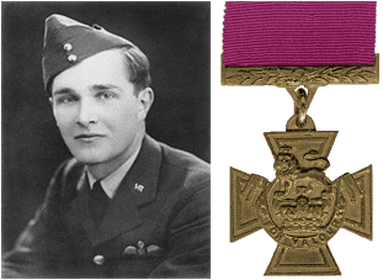
66542 Flying Officer
Leslie Thomas Manser, V. C.
50 Squadron, Royal Air Force Volunteer Reserve
31st May 1942, aged 20.
Plot 7. G. 1.,
Son of Thomas James Stedman Manser and Rosaline Manser, of Radlett, Hertfordshire.
His headstone bears the inscription "Beloved Son Of T. J. S. And R. Manser, Radlett, Herts. England" "He died To Do His Duty"
Citation:
The citation in the London Gazette of 20th October, 1942 gives the following details : Flying Officer Manser was captain and first pilot of an aircraft which took part in the mass raid on Cologne on the night of 30th May, 1942. Despite searchlights and intense and accurate anti-aircraft fire he held his course and bombed the target successfully from 7,000 feet. Thereafter, although he took evasive action, the aircraft was badly damaged, for a time one engine and part of one wing were on fire, and in spite of all the efforts of pilot and crew, the machine became difficult to handle and lost height. Though he could still have parachuted to safety with his crew, he refused to do so and insisted on piloting the aircraft towards its base as long as he could hold it steady, to give his crew a better chance of safety when they jumped. While the crew were descending to safety, they saw the aircraft, still carrying the gallant captain, plunge to earth and burst into flames. In pressing home his attack in the face of strong opposition, in striving against heavy odds to bring back his aircraft and crew, and finally, when in extreme peril, thinking only of the safety of his comrades, Flying Officer Manser displayed determination and valour of the highest order.
Leslie Thomas Manser, V. C.
50 Squadron, Royal Air Force Volunteer Reserve
31st May 1942, aged 20.
Plot 7. G. 1.,
Son of Thomas James Stedman Manser and Rosaline Manser, of Radlett, Hertfordshire.
His headstone bears the inscription "Beloved Son Of T. J. S. And R. Manser, Radlett, Herts. England" "He died To Do His Duty"
Citation:
The citation in the London Gazette of 20th October, 1942 gives the following details : Flying Officer Manser was captain and first pilot of an aircraft which took part in the mass raid on Cologne on the night of 30th May, 1942. Despite searchlights and intense and accurate anti-aircraft fire he held his course and bombed the target successfully from 7,000 feet. Thereafter, although he took evasive action, the aircraft was badly damaged, for a time one engine and part of one wing were on fire, and in spite of all the efforts of pilot and crew, the machine became difficult to handle and lost height. Though he could still have parachuted to safety with his crew, he refused to do so and insisted on piloting the aircraft towards its base as long as he could hold it steady, to give his crew a better chance of safety when they jumped. While the crew were descending to safety, they saw the aircraft, still carrying the gallant captain, plunge to earth and burst into flames. In pressing home his attack in the face of strong opposition, in striving against heavy odds to bring back his aircraft and crew, and finally, when in extreme peril, thinking only of the safety of his comrades, Flying Officer Manser displayed determination and valour of the highest order.
Some of the World War Two Graves
Pictures © Werner Van Caneghem
TO THE MEMORY OF SQUADRON LEADER DONALD WILLIAM MANSBRIDGE,
AFC, RAF, AND HIS CREW
Courtesy of Jean-Michel Dominique
On the night of 20-21 April I944, lancaster III ND826 F2-W of 635 (PFF) Squadron, Bomber Command, crashed at Dion-le-Mont, 2.5 miles ESE of Wavre, having taken off from RAF Downham Market in Norfolk at 21.28 hours. All seven crew now rest in Heverlee War Cemetery. Their skipper, Donald William Mansbridge AFC had completed 42 operational sorties. Their target was Ottignies railway station, an important junction on the Brussels-Luxembourg line, just SSW of Wavre.
The crew's luck ran out on the night of 20-21 April 1944, by which time they had transferred from 97 Squadron. All were killed except the rear gunner, Percival Ashford Walder, who had flown with them on many sorties but who was not on the doomed flight, probably because by then he had finished his tour (he was to survive the war). The tail-end Charlie on this occasion was Ernest Barrell who only operated three times with Mansbridge. It seems that after Walder left the crew, there were several changes of rear gunner. William 'Whitey' White had completed his first tour (30 operational sorties) with 49 Squadron. S/L Mansbridge was the husband of Letitia Joyce Mansbridge, of 54 Longfield Avenue, West End, Fareham, Hampshire.
The crew's luck ran out on the night of 20-21 April 1944, by which time they had transferred from 97 Squadron. All were killed except the rear gunner, Percival Ashford Walder, who had flown with them on many sorties but who was not on the doomed flight, probably because by then he had finished his tour (he was to survive the war). The tail-end Charlie on this occasion was Ernest Barrell who only operated three times with Mansbridge. It seems that after Walder left the crew, there were several changes of rear gunner. William 'Whitey' White had completed his first tour (30 operational sorties) with 49 Squadron. S/L Mansbridge was the husband of Letitia Joyce Mansbridge, of 54 Longfield Avenue, West End, Fareham, Hampshire.
THE MANSBRIDGE CREW as of April I944. (L-R): S/L Donald William Mansbridge RAF age 30, F/O Gerald Herbert Cruwys RAF (Nav) age 22, W/O William Courtney 'Whitey' White DFM RAFVR (AB) age 34, W/O John Richard 'Happy' Hanson RAFVR (WOp) age 21, F/S Ernest 'Butch' Hambling DFM RAFVR (A/G) age unknown, F/S Ernest Rowe Newton Barrell RAFVR (A/G) age 29, W/O Albert Stanley 'Tich' Palmer DFM RAF (F/E) age 24
(picture taken after they had joined 635 Squadron)

992916 Flight Sergeant
Ernest Rowe Newton Barrell
Air Gunner in 635 Squadron
Royal Air Force Volunteer Reserve
killed 20th April 1944, aged 29.
Coll. grave 2. G. 1-7.
Son of George and Edith Barrell; husband of Annie Barrell, of Prescot, Lancashire.
Ernest Rowe Newton Barrell
Air Gunner in 635 Squadron
Royal Air Force Volunteer Reserve
killed 20th April 1944, aged 29.
Coll. grave 2. G. 1-7.
Son of George and Edith Barrell; husband of Annie Barrell, of Prescot, Lancashire.

135442 Flying Officer
Gerald Herbert Cruwys
Navigator/Bomber in 635 Squadron, Royal Air Force
killed 20th April 1944, aged 22.
Coll. grave 2. G. 1-7.
Croix de Guerre avec Palm. Son of Herbert Frederick and Edith Florence Cruwys, of Cheltenham, Gloucestershire.
Gerald Herbert Cruwys
Navigator/Bomber in 635 Squadron, Royal Air Force
killed 20th April 1944, aged 22.
Coll. grave 2. G. 1-7.
Croix de Guerre avec Palm. Son of Herbert Frederick and Edith Florence Cruwys, of Cheltenham, Gloucestershire.
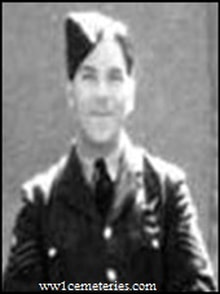
928499 Flight Sergeant
Ernest Hambling D. F. M.
Air Gunner in 635 Squadron
Royal Air Force Volunteer Reserve
killed 20th April 1944.
Coll. grave 2. G. 1-7.
Ernest Hambling D. F. M.
Air Gunner in 635 Squadron
Royal Air Force Volunteer Reserve
killed 20th April 1944.
Coll. grave 2. G. 1-7.

1284645 Warrant Officer
John Richard Hanson
Wireless Operator/Air Gunner in 635 Squadron
Royal Air Force Volunteer Reserve
killed 20th April 1944, aged 21.
Coll. grave 2. G. 1-7.
Son of Ronald Clarence Hanson, and of Mabel Violet Hanson, of Hucclecote, Gloucestershire.
John Richard Hanson
Wireless Operator/Air Gunner in 635 Squadron
Royal Air Force Volunteer Reserve
killed 20th April 1944, aged 21.
Coll. grave 2. G. 1-7.
Son of Ronald Clarence Hanson, and of Mabel Violet Hanson, of Hucclecote, Gloucestershire.
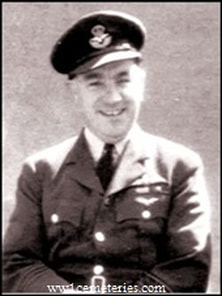
45151 Squadron Leader
Donald William Mansbridge A. F. C.
Pilot in 635 Squadron, Royal Air Force
killed 20th April 1944, aged 30.
Coll. grave 2. G. 1-7.
Son of William and Alice Mansbridge; husband of Letitia Joyce Mansbridge, of Fareham, Hampshire.
Donald William Mansbridge A. F. C.
Pilot in 635 Squadron, Royal Air Force
killed 20th April 1944, aged 30.
Coll. grave 2. G. 1-7.
Son of William and Alice Mansbridge; husband of Letitia Joyce Mansbridge, of Fareham, Hampshire.
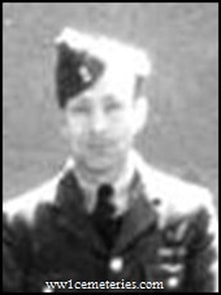
643812 Warrant Officer
Albert Stanley Palmer D. F. M.
Flight Engineer in 635 Squadron, Royal Air Force
killed 20th April 1944, aged 24.
Coll. grave 2. G. 1-7.
Son of Mr. and Mrs. Albert Palmer; husband of Florence Rona Palmer, of Canton, Cardiff.
Albert Stanley Palmer D. F. M.
Flight Engineer in 635 Squadron, Royal Air Force
killed 20th April 1944, aged 24.
Coll. grave 2. G. 1-7.
Son of Mr. and Mrs. Albert Palmer; husband of Florence Rona Palmer, of Canton, Cardiff.

1311804 Warrant Officer
William Courtney White
Air Bomber in 635 Squadron
Royal Air Force Volunteer Reserve
killed 20th April 1944, aged 34.
Coll. grave 2. G. 1-7.
Son of William Henry and Christian Jane White; husband of Gertrude May White, of West Croydon, Surrey.
William Courtney White
Air Bomber in 635 Squadron
Royal Air Force Volunteer Reserve
killed 20th April 1944, aged 34.
Coll. grave 2. G. 1-7.
Son of William Henry and Christian Jane White; husband of Gertrude May White, of West Croydon, Surrey.
(L-R) Percival Walder, S/L Alfred Eaton-Clarke, the bride, F/L Carlton, W/C Alabaster, F/S Hambling,
W/O Smith (Picture taken at Eaton-Clarke's wedding, possibly in November 1943)
W/O Smith (Picture taken at Eaton-Clarke's wedding, possibly in November 1943)
Auxiliary Territorial Service

W/77979 Private
Clara Carter
Auxiliary Territorial Service attched to 457 Battery, 132 (Mixed) H. A. A. Regiment, Royal Artillery
7th May 1945, aged 26.
Plot I. A. 1.
Daughter of George and Sarah Ann Carter.
Her headstone bears the inscription "Always Remembered"
Clara Carter
Auxiliary Territorial Service attched to 457 Battery, 132 (Mixed) H. A. A. Regiment, Royal Artillery
7th May 1945, aged 26.
Plot I. A. 1.
Daughter of George and Sarah Ann Carter.
Her headstone bears the inscription "Always Remembered"

W/108074 Lance Corporal
Marie Rose
Auxiliary Territorial Service attached to 139 (Mixed) H. A. A. Regiment, Royal Artillery
13th January 1945, aged 24.
Plot I. A. 4.
Daughter of Mr. and Mrs. W. Rose, of Willenhall, Staffordshire.
Her headstone bears the inscription "Not Good-Bye, Darling But Au Revoir, For We'll Meet Again On the Golden Shore"
Marie Rose
Auxiliary Territorial Service attached to 139 (Mixed) H. A. A. Regiment, Royal Artillery
13th January 1945, aged 24.
Plot I. A. 4.
Daughter of Mr. and Mrs. W. Rose, of Willenhall, Staffordshire.
Her headstone bears the inscription "Not Good-Bye, Darling But Au Revoir, For We'll Meet Again On the Golden Shore"

